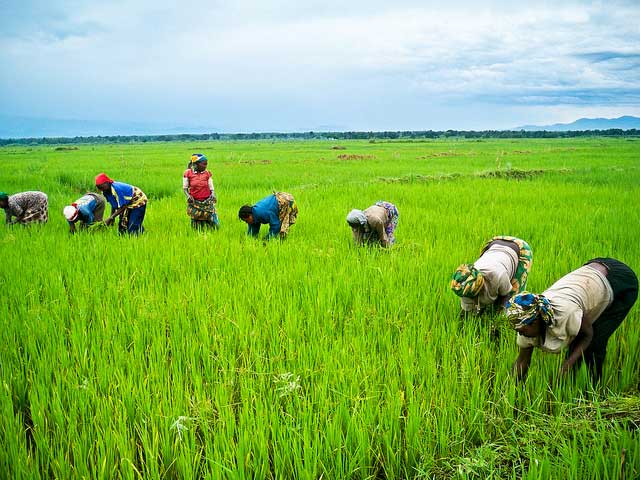How to control weeds
 Weed control is important to prevent losses in yield and production costs, and to preserve good grain quality. Specifically, weeds
Weed control is important to prevent losses in yield and production costs, and to preserve good grain quality. Specifically, weeds
- decrease yields by direct competition for sunlight, nutrients, and water
- increase production costs e.g., higher labor or input costs
- reduce grain quality and price
For example, weed seeds in grain can cause the buyer price to be reduced.
Weed management should be practiced during specific stages of rice production:
During land preparation
Control of weeds during land preparation is crucial to reduce the amount of weed pressure in the field. Land preparation should start 3−4 weeks before planting. Plowing destroys weeds and remaining stubble from the previous crop. Weeds should be allowed to grow before the next cultivation. In addition, a level field helps retain a constant water level that controls weeds.
 For wet seeded rice
For wet seeded rice
- Plow and harrow several times before planting. Depending on weed population, three or more operations can be done.
- Allow weeds to emerge for at least 2 weeks then kill by another shallow tillage. This reduces the number of weed seeds in the soil, and greatly reduces weeds for the subsequent crop.
 For dry seeded rice
For dry seeded rice
- Allow weeds to emerge within 1−2 weeks, then kill them with either a non-selective herbicide or by light cultivation.
- Spray herbicides, and perform manual and/or mechanical weeding.
Fact sheets: Chemical weed control | Cultural weed control
In the nursery
To control weeds in the nursery
- Prepare land two weeks before seeding.
- When using soil mix for nursery beds, make sure the soil is clean and free of weed seeds.
- If there are weed seedlings in the nursery bed, separate them from rice seedlings during pulling and bundling to avoid planting weeds.
- Apply pre-emergence herbicide 2−3 DAS.
Fact sheets: Chemical weed control | Cultural weed control
During early crop growth
Weed control is critical after planting until the canopy closes. Control methods vary depending on the rice ecosystem and planting method:
 For transplanted rice
For transplanted rice
- Apply pre-emergence herbicide (e.g., pretilachlor or butachlor at 2−3 DAT)
- If grass weeds are the main weed problem, apply early post-emergence herbicide
- Do not allow soil surface to dry after transplanting. Keep the soil moist to saturated. Dry soil reduces the performance of pre-emergence herbicides.
- Maintain a 5−7 cm water depth to prevent germination of weeds until 7−10 days before harvest.
- If herbicides have not been applied, or if weeds are emerging, you may use push weeder to control weed seedlings that are at 3−4 leaf stages. Irrigate one day later to prevent buried and uprooted weeds from recovering.
-
- Maintain shallow flooding 7−10 DAT, drain the field, then push the weeder down the row to bury emerged weed seedlings.
- Leave the field saturated for 2 days to keep the buried weed seedling in the mud layer then flood the field up to 5 cm of water.
- Handweed as needed until the canopy closes.
 For wet seeded rice (broadcast or drum seeded)
For wet seeded rice (broadcast or drum seeded)
- Apply pre-emergence herbicide (e.g., pretilachlor + fenclorim 2−3 DAS)
- If grass weeds are the main weed problem, apply early post-emergence herbicide
Note: Post-emergence herbicide should come in contact with leaves of weeds to be absorbed by the weeds. When weeds are submerged in water, post-emergence herbicide will not be effective.
- Do not allow soil surface to dry after seeding. Flush irrigate as needed to keep the soil moist to saturated. A dried soil surface will reduce the performance of pre-emergence herbicides. Irrigating more than 10 days after seeding encourages more weed growth and deeper water level is needed to control weeds.
- If herbicides have not been applied, or if weeds are emerging, you may use push weeder in a row-seeded crop to control weed seedlings that are at 3−4 leaf stages. Irrigate one day later to prevent buried and uprooted weeds from recovering.
- Maintain a 5−7 cm water depth to prevent germination of weeds until 7−10 days before harvest.
- Handweed as needed until the canopy closes.
 For dry seeded rice
For dry seeded rice
- A weed-free field is essential for early vigor in a dry-seeded rice crop. Be sure to follow steps for weed control during land preparation to avoid yield loss to weeds.
- Apply pre-emergence herbicide (e.g., oxadiazon or pendimethalin) onto a moist soil 2−3 DAS. If the seed is sown on dry soil, flush irrigate the field first then spray the herbicide.
Pre-emergence herbicides should not be applied in standing water to avoid toxicity.
Read: Knockdown and pre-emergence herbicide in DSR (pdf) from Direct Seeded Rice (DSR) in the Eastern Gangetic Plains of India
- Handweed as needed until the canopy closes.



